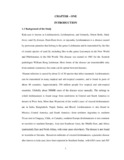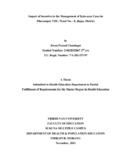Please use this identifier to cite or link to this item:
https://elibrary.tucl.edu.np/handle/123456789/3580| Title: | Impact of Incentive in the Management of Kala-azar Cases in Dharampur VDC, Ward No – 8, Jhapa, District |
| Authors: | Chamlagai, Jiwan Prasad |
| Keywords: | socio-demographic;Incentive;Kala-azar disease |
| Issue Date: | Nov-2011 |
| Publisher: | Faculty of Education |
| Level: | Masters |
| Abstract: | Health is a fundamental human right. The individual, the community, the nation and government all have to play their respective role collectively and actively in the area of health. We must be aware of our health; otherwise we will have to face many health problems. If we go through the health profile of our country, lack of health education is the major factor for creating health problems. The morbidity rate of Kala-azar is found very high in endemic districts of Nepal. This study has tried to find out the impact of incentive in the management of Kala-azar cases in Dharampur VDC, Ward No – 8, Jhapa, District. The objective of the study was to find out the socio-demographic characteristics of kala- azar related community, to find out impact of incentive in the management of Kala-azar cases in Dharampur VDC, Ward No – 8, jhapa district, to identify people's health seeking behaviour with respect to Kala-azar treatment and use of incentive. Structural questionnaire was prepared for the study and pretest and revised. The study was done in March to August 2011 and the sample size was 105 households and 625 populations. Systemic sampling method was followed for the study. The data was analyzed with the help of simple statistical law such as percentage, value etc. as necessary these data was presented in simple descriptive method, table, figures, pie chart and bar diagrams as per as convenience and necessary. Among the total population 52 % was male and 48 % was female. . The 37% peoples of study area were illiterate and 56.6% of the respondents were from Adibasi and Dalit. Majority (97%) of the respondents were known infected female Sand fly bite is the mode of transmission of Kala-azar. Majority (93.3%) of the respondents noted that the main symptoms of Kala-azar are fever & Spleenomegaly. Among the total respondents 105 households, 22% were suffering from Kala-azar. Total numbers of the Kala-azar patients were 23 in which 100% were get complete treatment of Kala-azar. 100 % of the Kala- azar patients were getting incentive after completing the treatment of Kala-azar which is Rs 1000 and one Supanet. The majorities (87%) of the respondents were spent money for fruits and meats; they are not spent money for Alcohol and Tobacco consumption. 100% of the total Kala-azar patients has been used the Supanet or insecticide treated net. 100% of the respondents are said don’t mosquito or sand fly bite after using Supanet at night. Majority 80% of the respondents were gone to the hospital, 19% were gone to Health Post when occur the signs and symptoms like Kala-azar. Total numbers of the Kala-azar patients were get complete treatment of Kala-azar After geting complete treatment of Kala-azar, all patients were cure and could not transmit Kala-azar to others. Majority of the respondents were known about the incentive after management of Kala-azar cases and total Kala-azar patients were getting incentive after completing the treatment of Kala-azar. It was not the gap between theory and practice. Majority of the respondents were get incentive from DPHO/HP or Government sector. The majority of the respondents were spent money for fruits and meats and they were not spent money for Alcohol and Tobacco consumption. The impact of the incentive found v very good because most of the respondents were spent money for useful purpose. It is found the positive impact of incentive and Kala-azar control and elimination program |
| URI: | http://elibrary.tucl.edu.np/handle/123456789/3580 |
| Appears in Collections: | Health Education |
Files in This Item:
| File | Description | Size | Format | |
|---|---|---|---|---|
| CHAPTER.pdf | 342.79 kB | Adobe PDF |  View/Open | |
| cover.pdf | 50.87 kB | Adobe PDF |  View/Open |
Items in DSpace are protected by copyright, with all rights reserved, unless otherwise indicated.
